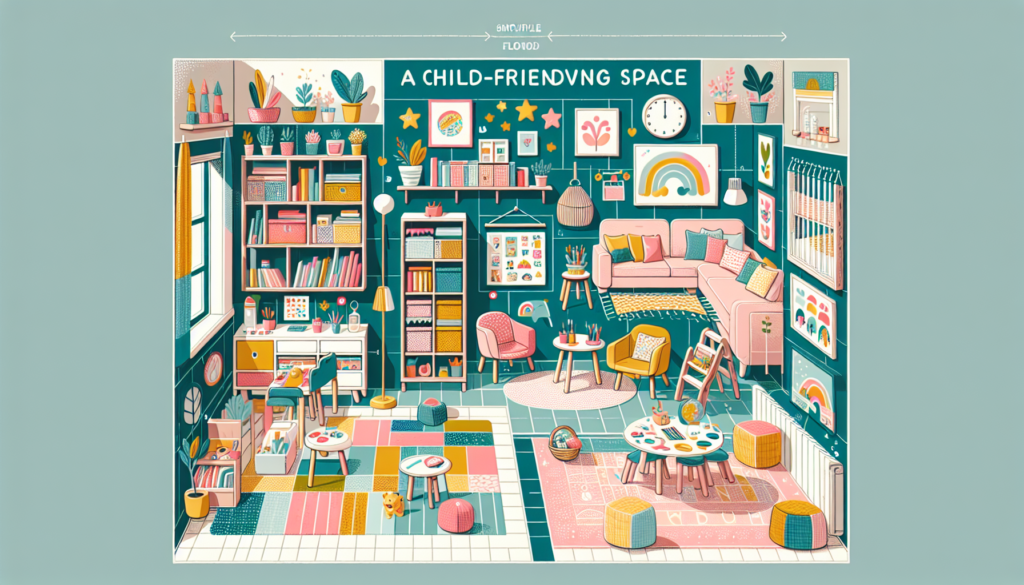Creating a living space that is both safe and inviting for children is essential for their overall well-being and development. In this article, you will discover practical tips and ideas on how to design a child-friendly living space, from choosing durable and easy-to-clean furniture to incorporating fun and educational elements into the decor. By making a few simple changes, you can transform your home into a welcoming haven where your little ones can play, learn, and thrive.
Designing A Child-Friendly Living Space
Designing a living space that is child-friendly is an essential aspect of creating a comfortable and safe environment for your children to grow and thrive. By understanding the needs and preferences of children, you can design a space that fosters their development and encourages their creativity and imagination. In this article, we will explore various factors to consider when designing a child-friendly living space, from choosing safe and durable materials to incorporating age-appropriate furniture and creating play areas and zones.

Understanding the Needs of Children
Before embarking on designing a child-friendly living space, it is essential to understand the unique needs and requirements of children. Children have diverse interests and developmental stages, and their living space should accommodate their changing needs. For instance, younger children may require more space for play and exploration, while older children may need designated areas for studying or pursuing hobbies. By considering the various aspects of a child’s life, you can create a living space that caters to their specific needs and promotes their overall well-being.
Choosing Safe and Durable Materials
When selecting materials for a child-friendly living space, it is crucial to prioritize safety and durability. Children are curious and often engage in activities that may result in accidental bumps, spills, or falls. Therefore, it is advisable to opt for materials that are easy to clean, resistant to stains, and are less prone to scratches or damage. Additionally, choosing non-toxic materials and avoiding sharp corners or edges can significantly reduce the risk of accidents and injuries.
Creating a Functional Layout
A functional layout plays a vital role in designing a child-friendly living space. By carefully planning the arrangement of furniture and considering the flow of movement, you can optimize the usability and efficiency of the space. It is advisable to maintain open areas for play and to ensure that pathways are clear and unobstructed. Moreover, allocating specific zones for different activities, such as sleeping or studying, can help establish a sense of order and routine in the child’s living space.
Considering Age-Appropriate Furniture
Choosing age-appropriate furniture is essential for creating a child-friendly living space. Furniture should not only be safe and sturdy but also cater to the height, comfort, and developmental needs of children. For instance, selecting adjustable desks and chairs can accommodate the growth spurts of growing children. Furthermore, incorporating furniture with rounded edges and minimal sharp corners can reduce the risk of injuries. By considering the age of your child when selecting furniture, you can create a space that is comfortable and promotes healthy posture and development.

Using Colors and Themes
Colors and themes are an excellent way to infuse fun and playfulness into a child-friendly living space. Incorporating bright and vibrant colors can stimulate creativity and imagination, while creating a visually appealing environment. Additionally, embracing themes that resonate with your child’s interests, such as princesses or superheroes, can contribute to their sense of identity and personalization within their living space. However, it is essential to strike a balance and avoid overwhelming the space with too many colors or themes, as that can hinder relaxation and concentration.
Maximizing Storage and Organization
In a child-friendly living space, it is crucial to maximize storage and organization options. Children tend to accumulate toys, books, and other belongings, and adequate storage solutions are necessary to maintain a clutter-free environment. Utilizing shelves, bins, and cabinets can help keep the space tidy and organized. Moreover, involving your child in the organization process by labeling storage containers or creating designated spaces for their belongings can instill a sense of responsibility and encourage them to maintain cleanliness and orderliness.
Implementing Safety Measures
Child safety should be a top priority when designing a child-friendly living space. Installing safety gates at staircases, using outlet covers, and securing heavy furniture to the wall are some of the essential measures to ensure a safe environment for children. Additionally, considering non-slip flooring options and using window safety locks can help prevent accidents and injuries. Regularly conducting safety checks and being aware of potential hazards within the living space can contribute to creating a safe and secure environment for your child.
Creating Play Areas and Zones
Designating specific play areas and zones within the living space is essential for promoting the development and well-being of children. A dedicated play area allows children to engage in imaginative play, exploration, and physical activities. By incorporating age-appropriate toys, such as building blocks or puzzles, and providing ample space for movement, you can encourage your child’s creativity and physical development. Moreover, creating cozy reading nooks or art corners can foster a love for reading and artistic expression.
Incorporating Child-Sized Features
To further enhance the child-friendliness of the living space, incorporating child-sized features can be beneficial. Child-sized furniture, such as tables and chairs, can provide a comfortable space for children to study, eat, or engage in various activities. Additionally, installing lower hooks or shelves at a reachable height can encourage independence and enable children to hang their coats or organize their belongings on their own. By tailoring certain elements of the living space specifically to the child’s size and needs, you create an environment that is inclusive and accommodating.
Promoting Creativity and Imagination
Lastly, a child-friendly living space should foster creativity and imagination. Providing opportunities for children to engage in imaginative play and artistic expression can contribute to their cognitive, emotional, and social development. Incorporating art supplies, musical instruments, or a designated space for creative projects can encourage your child’s exploration of different mediums and self-expression. Moreover, allowing flexibility and adaptability within the living space, such as movable furniture or versatile play areas, can inspire curiosity and encourage children to create and imagine freely.
In conclusion, designing a child-friendly living space involves considering the unique needs and requirements of children. From choosing safe and durable materials to creating functional layouts and incorporating age-appropriate furniture, every aspect plays a crucial role in promoting the well-being and development of your child. By prioritizing safety, maximizing storage and organization options, implementing safety measures, and creating designated play areas and zones, you can create a space that nurtures your child’s creativity, imagination, and overall happiness.

